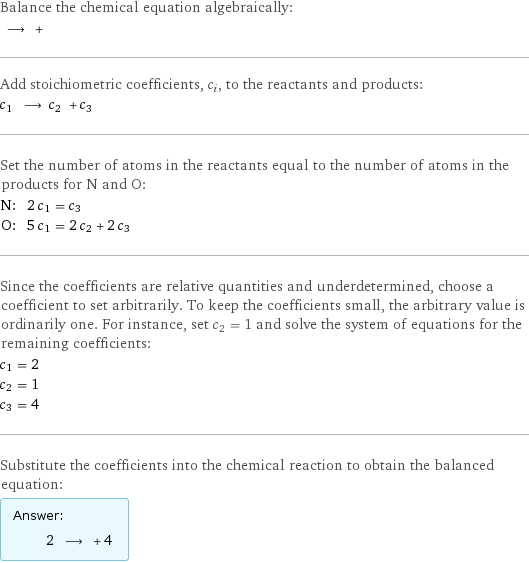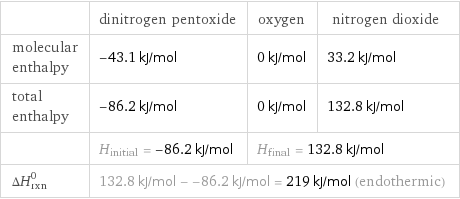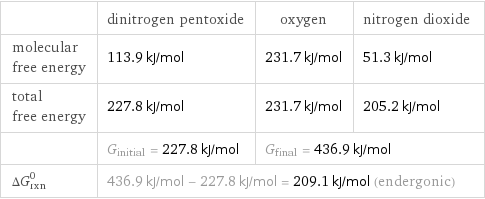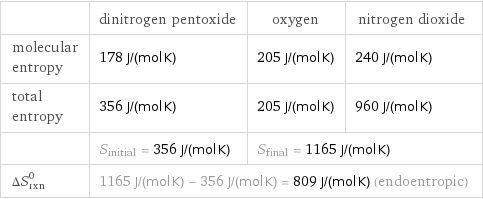Input interpretation

dinitrogen pentoxide ⟶ oxygen + nitrogen dioxide
Balanced equation

Balance the chemical equation algebraically: ⟶ + Add stoichiometric coefficients, c_i, to the reactants and products: c_1 ⟶ c_2 + c_3 Set the number of atoms in the reactants equal to the number of atoms in the products for N and O: N: | 2 c_1 = c_3 O: | 5 c_1 = 2 c_2 + 2 c_3 Since the coefficients are relative quantities and underdetermined, choose a coefficient to set arbitrarily. To keep the coefficients small, the arbitrary value is ordinarily one. For instance, set c_2 = 1 and solve the system of equations for the remaining coefficients: c_1 = 2 c_2 = 1 c_3 = 4 Substitute the coefficients into the chemical reaction to obtain the balanced equation: Answer: | | 2 ⟶ + 4
Structures

⟶ +
Names

dinitrogen pentoxide ⟶ oxygen + nitrogen dioxide
Reaction thermodynamics
Enthalpy

| dinitrogen pentoxide | oxygen | nitrogen dioxide molecular enthalpy | -43.1 kJ/mol | 0 kJ/mol | 33.2 kJ/mol total enthalpy | -86.2 kJ/mol | 0 kJ/mol | 132.8 kJ/mol | H_initial = -86.2 kJ/mol | H_final = 132.8 kJ/mol | ΔH_rxn^0 | 132.8 kJ/mol - -86.2 kJ/mol = 219 kJ/mol (endothermic) | |
Gibbs free energy

| dinitrogen pentoxide | oxygen | nitrogen dioxide molecular free energy | 113.9 kJ/mol | 231.7 kJ/mol | 51.3 kJ/mol total free energy | 227.8 kJ/mol | 231.7 kJ/mol | 205.2 kJ/mol | G_initial = 227.8 kJ/mol | G_final = 436.9 kJ/mol | ΔG_rxn^0 | 436.9 kJ/mol - 227.8 kJ/mol = 209.1 kJ/mol (endergonic) | |
Entropy

| dinitrogen pentoxide | oxygen | nitrogen dioxide molecular entropy | 178 J/(mol K) | 205 J/(mol K) | 240 J/(mol K) total entropy | 356 J/(mol K) | 205 J/(mol K) | 960 J/(mol K) | S_initial = 356 J/(mol K) | S_final = 1165 J/(mol K) | ΔS_rxn^0 | 1165 J/(mol K) - 356 J/(mol K) = 809 J/(mol K) (endoentropic) | |
Chemical names and formulas

| dinitrogen pentoxide | oxygen | nitrogen dioxide Hill formula | N_2O_5 | O_2 | NO_2 name | dinitrogen pentoxide | oxygen | nitrogen dioxide IUPAC name | nitro nitrate | molecular oxygen | Nitrogen dioxide